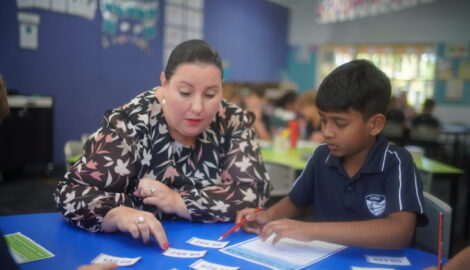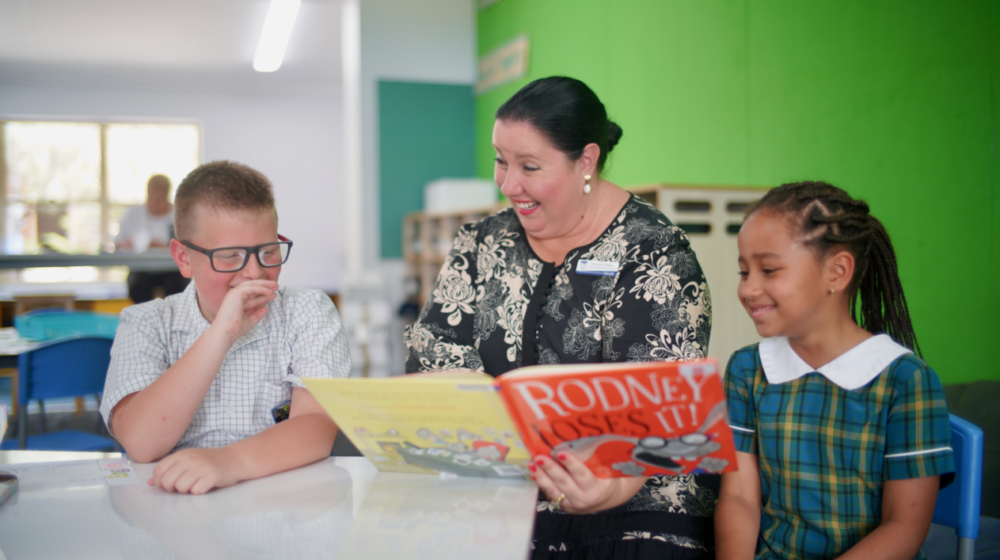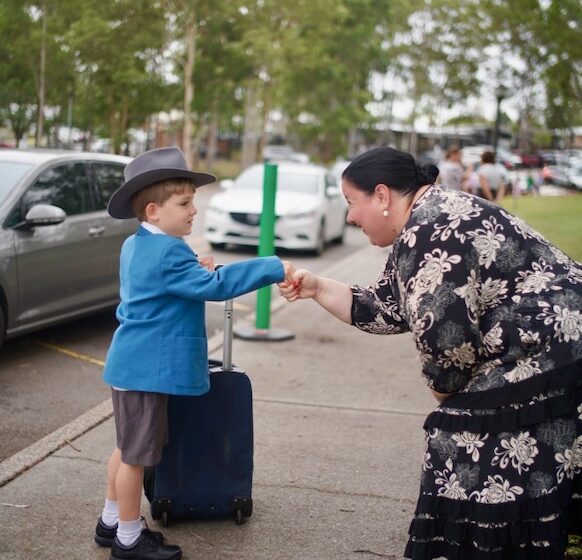Published on March 7, 2024
Language matters. The way we speak to students has an impact on how they think, feel, form relationships, and process the world.
At HVGS, teachers use language intentionally. In their daily interactions with students, teachers choose words that are impactful. They use language to motivate, build confidence, and support brain development.

Here’s what HVGS teachers say to help your child thrive:
-
“Hello!”, “Good to see you!”, “Friends!”
Teachers are not only supervising the Pick-Up/Drop-Off Zone to ensure safety. They are also there to make connections. HVGS teachers start and end every day with the language of social connection. They use your child’s name in warm, personal greetings. One of the most basic human needs is to be seen and acknowledged. When children believe teachers like and care about them, they achieve better academic results. Teacher-student relationships underpin motivation, risk-taking and cognition. That is, when children feel cared for, they try harder, persist longer, and achieve more. When speaking to the class, HVGS teachers often say, “Friends, look at the board,” or “Friends, listen carefully.” By referring to the class as a community of friends, HVGS teachers reinforce a sense of belonging and inclusion, every day.
-
“What makes you say that?”
This is the most powerful question HVGS teachers ask in your child’s classroom. This question disrupts the traditional cycle of:
a) The teacher asking the questions.
b) The student giving an answer.
c) The teacher commenting on the accuracy of the answer.
This question prevents students from thinking that school is a game of ‘guess what’s in my teacher’s head’. With this question, teachers invite students to share their reasoning, to give evidence for their answer, and to justify their ideas. This question creates ‘thinking classrooms’. As such, HVGS students receive the message that reasoning is as valuable as knowledge. Students feel more engaged and more challenged. When children know that teachers expect them to think, they rise to our high expectations.
-
“Tell me what you’re doing.”
Most children relish the feeling of ‘finishing the job and ‘getting it done’. To prevent students from rushing, HVGS teachers sit alongside students mid-way through a task. Through conferencing, they inject analysis and evaluation into the learning process. Teachers invite students to state their goal, explain their plans, edit their writing or review their responses. In doing so, they teach metacognition. This is your child’s ability to ‘think about their own thinking’. It is essential for reflection and improvement. “Tell me what you’re doing” is the beginning of a rich dialogue, that facilitates deep learning.
-
“This matters to you.”
Why do I need fractions?
Who cares about handwriting – I have a computer!
I’m not interested in history.
I’m sure these are familiar refrains. We know that students’ achievement drastically increases when they feel a sense of purpose. Without understanding how the learning is personally relevant (‘to me’), we cannot expect children to engage. HVGS teachers therefore take time to explain what the Unit of Inquiry is about, how students will know if they’ve been successful, and most importantly, why it matters in the real world. The PYP curriculum is designed to embed knowledge and skills in authentic local and global contexts. As an IB School, the world is our curriculum! HVGS students spend time exploring interpersonal situations, news events, current affairs, and real world problems. Traditional disciplines (such as History, Geography, Science) are the vehicles through which students explore the world. HVGS teachers take time to share ‘the point’ of each activity, making learning relevant and engaging.
-
“Let’s review.”
HVGS teachers know that learning is fragile. If students are not given sufficient time to review, reflect and consolidate new knowledge, it can be lost. The HVGS timetable includes a formal Review Period, every day. In addition, at the beginning of each lesson/unit, teachers give students time to tune into the content, to activate their prior knowledge and to get ready to learn. At the end of every lesson/unit, they give students time to practise skills, to put facts in their own words, to draw the big idea, or to apply it in their own way. Thus, teachers make learning ‘sticky’ for students, so it less likely to be lost as they dash for the bus, and more likely to become an enduring understanding that is stored in long-term memory.
-
“I’m sorry.”
HVGS teachers model integrity. It is one of our Values for Life. They show children that everyone makes mistakes, even adults. They are not afraid to apologise, reflect and re-set the class climate. During writing or maths lessons, teachers think out loud about their own creative decisions and problem-solving strategies. In doing so, they make classrooms safe places for children to take risks, to make mistakes and to learn from their errors. When students play it safe, they are less likely to reach their potential or achieve at their best. Our teachers help students understand that mistakes are integral to learning.
-
[Nothing]
In some classrooms, teachers talk too much. At HVGS, we know that lengthy explanations and detailed expositions are the fastest way to lose a child’s interest. We know that students themselves need opportunities to discuss, question, and debate ideas. HVGS teachers understand that ‘the person doing the talking is most likely the person doing the learning’. And so, HVGS teachers often pause, prompt, and probe. They stay silent for an extra moment, giving students the chance to think, speak and discuss. This ensures that students do the cognitive heavy-lifting in each lesson.

Parents can help!
The great news is that parents can use the same language structures at home.
Each of the questions and statements above can be included in family discussions around the dinner table, chats in the car, or debriefs before bedtime.
Just don’t use them all at once! Parents are encouraged to choose one new language structure to add to their repertoire. And remember, less is more when talking to children. Parents should avoid interrogating their child, and instead take an inquisitive approach during conversations. Be curious about their computer games. Withhold judgment on their friendship choices. Affirm their ability to solve their own problems, by letting them talk to the teacher. This builds trust in parent-child relationships.
If in doubt, we are here to help. The lines of communication are always open between parents and teachers. As a school community, we are delighted to support your child’s development.
Ms Shannon O’Dwyer
Deputy Principal & Head of Junior School

Johnston, P.H. 2004. Choice Words: How Our Language affects Children’s Learning. Maine: Stenhouse Publishers.
Ritchhart, R., 2015. Creating cultures of thinking: The 8 forces we must master to truly transform our schools. 1st ed.

